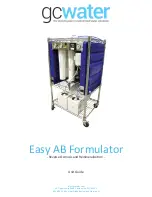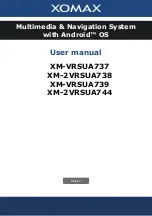
Safety
7
Use of Personal Protective Equipment
• People working in areas where there are potential electrical hazards must use, personal protective equipment
that is appropriate for the specific parts of the body to be protected and for the work to be performed. Refer to
U.S. Occupational Safety & Health Administration (OSHA) Regulations (Standards - 29 CFR) Safeguards for
personnel protection. - 1910.335, or applicable national, state or local regulations, for additional information.
• Personal protective equipment must be maintained in a safe, reliable condition and periodically inspected or
tested.
• Protective shields, protective barriers, or insulating materials must be used to protect each person from
shock, burns, or other electrically-related injuries while that person is working near exposed energized parts
which might be accidentally contacted or where dangerous electric heating or arcing might occur. When nor-
mally enclosed live parts are exposed for maintenance or repair, they must be guarded to protect unqualified
persons from contact with the live parts.
• Safety signs and tags. Safety signs, safety symbols, or accident prevention tags must be used where neces-
sary to warn people about electrical hazards which may endanger them.
Conductive Materials and Equipment
Materials and equipment that can conduct electricity must be handled in a way that will prevent them from
contacting energized power lines, exposed conductors or circuit parts.
• When handling long conductive objects (such as but not limited to truss rods, pipes, angles and ladders) in
areas with energized power lines, exposed conductors or circuit parts, work practices (such as the use of
insulation, guarding, and material handling techniques) must be used to minimize the hazard.
• Portable ladders must have non-conductive side rails.
• Do not wear conductive articles of jewelry and clothing (such as but not limited to watch bands, bracelets,
rings, key chains, necklaces, metalized aprons, cloth with conductive thread, or metal headgear) that could
come in contact with energized power lines, exposed conductors or circuit parts.
Fall Protection
Identify potential fall hazards and determine if fall protection equipment is appropriate for the task, before begin-
ning the work. Pay attention to hazards associated with routine and non-routine tasks. Inspect fall protection
equipment (harnesses, lanyards) and devices (guardrails, tie-off points) before each use. Use fall protection
equipment if required for the job. Be sure the fall protection equipment is right for the task, fits properly, and is in
good condition. Refer to U.S. Occupational Safety & Health Administration (OSHA) Regulations Standards - 29
CFR 1926.500, 1926.501 and 1926.502, or applicable national, state or local regulations for more information.
• When using scaffolds, make sure there is proper access, full planking, stable footing, and guard railing.
• When using a boom lift, keep feet firmly on the platform of a boom lift, use fall protection equipment tied-off
at all times to the guardrail or tie-off point.
• When using a ladder, make sure the ladder is non-conductive and the correct size for the task. Read the
ladder user instructions and be sure the ladder is in good condition. Make sure ladder is set on stable footing
and at the correct angle.
Содержание VRI-iS
Страница 2: ...2 This page was left blank intentionally...
Страница 44: ...This page was left blank intentionally 44 Setup...
Страница 50: ...50 Field Install and Wiring Diagrams VRI iS Power Supply Tower Box Field Install pn 9312421...
Страница 51: ...51 Field Install and Wiring Diagrams VRI iS Power Supply Tower Box Wiring Schematic pn 0999334...
Страница 52: ...52 Field Install and Wiring Diagrams VRI iS GPS Position Tower Box Field Install pn 9312419...
Страница 53: ...53 Field Install and Wiring Diagrams VRI iS GPS Position Tower Box Wiring Schematic pn 0999346...
Страница 82: ...82 Troubleshooting This page was left blank intentionally...
Страница 102: ...102 Parts This page was left blank intentionally...








































